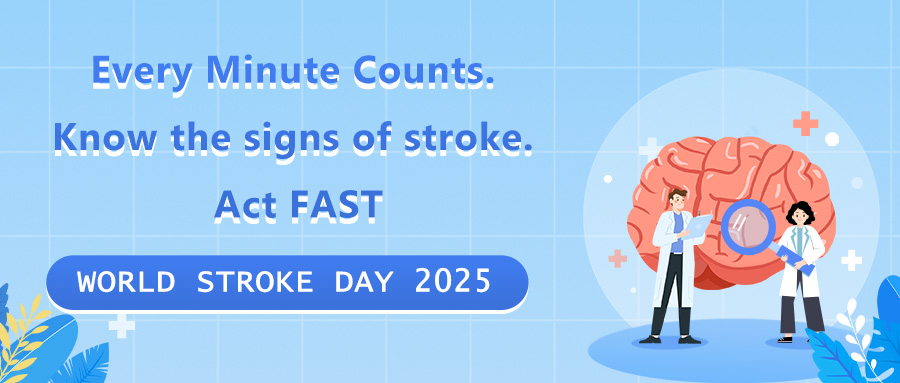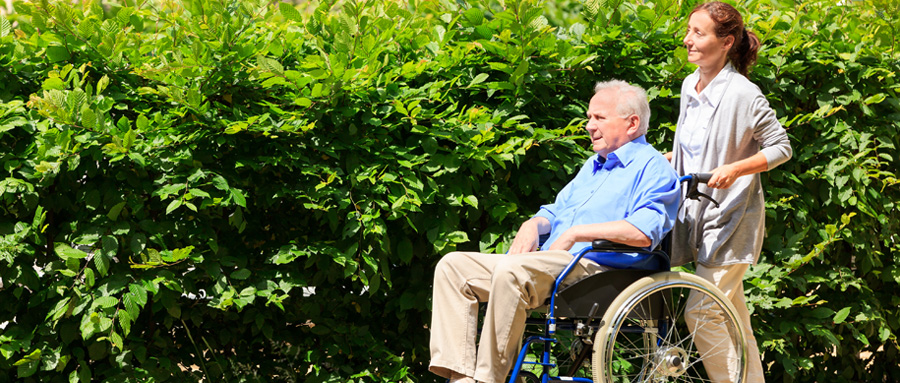World Stroke Day 2025: A Complete Guide from Prevention to Recovery
This World Stroke Day, empower yourself with the complete guide. Learn how to recognize the signs, act in an emergency, prevent risk factors, and navigate the path to recovery for a healthier future.
- World Stroke Day 2025: A Complete Guide from Prevention to Recovery
- I. Understanding Stroke: Sudden Onset, Severe Hazards, and Early Recognition is Key
- (I) The "BE FAST" Mnemonic: The "Golden Rule" for Rapid Stroke Recognition
- II. Responding to Stroke: Race Against Time and Handle Properly to Ensure Safety
- (I) The "Three Don'ts" While Waiting for the Ambulance
- (II) Choosing a Hospital: Prioritize Hospitals with Stroke Emergency Capabilities
- III. Preventing Stroke: Proactive Prevention and Healthy Lifestyle as the Foundation
- (I) High-Risk Groups: Regular Screening and Timely Intervention
- (II) Healthy Lifestyle: Start from Details to Reduce Risks
- IV. Stroke Rehabilitation: Reducing Disability Rate, with Professional Intervention as the Key
- (I) Rehabilitation Intervention: Initiate Immediately After the Condition Stabilizes
- (II) Professional Rehabilitation Equipment: Assisting in Functional Recovery
- V. Conclusion: Face Stroke Correctly and Respond Scientifically Without Panic
World Stroke Day 2025: A Complete Guide from Prevention to Recovery

I. Understanding Stroke: Sudden Onset, Severe Hazards, and Early Recognition is Key

(I) The "BE FAST" Mnemonic: The "Golden Rule" for Rapid Stroke Recognition
- B (Balance) – Balance Disorder: Sudden loss of balance or coordination, unsteady walking, and increased risk of falling.
- E (Eyes) – Vision Abnormalities: Sudden changes in vision, such as blurred vision, double vision, or even a sudden decrease in vision in one or both eyes.
- F (Face) – Facial Asymmetry: Observe the face; if there is sudden facial drooping or numbness on one side, and the facial expressions are inconsistent when attempting to smile, high vigilance is required.
- A (Arms) – Arm Weakness: When raising both arms, if one arm suddenly becomes weak or numb and cannot maintain the raised position, it may be a sign of stroke.
- S (Speech) – Speech Difficulty: Sudden slurred speech, difficulty expressing oneself, inability to understand others' words, or logical confusion even when able to speak.
- T (Time) – Seek Medical Help Immediately: Once any of the above symptoms are detected, do not wait for the symptoms to subside on their own. Immediately call the emergency number (120 in China) and record the onset time to provide reference for doctors' treatment.
II. Responding to Stroke: Race Against Time and Handle Properly to Ensure Safety
(I) The "Three Don'ts" While Waiting for the Ambulance
- Don't drag the patient: Keep the patient in the most comfortable position (e.g., side-lying to prevent vomit from blocking the respiratory tract). Avoid forced moving or dragging, especially for patients with hemorrhagic stroke, as this may lead to the expansion of hematomas.
- Don't feed or give water to the patient: Never give the patient any food or water, even if they are thirsty. This is to prevent aspiration caused by vomiting, which may lead to aspiration pneumonia or acute respiratory obstruction.
- Don't miss key information: Accurately record the patient's onset time and symptom changes, such as "when facial drooping appeared" or "whether there was confusion". After arriving at the hospital, inform the doctor in detail to help them quickly assess the condition and formulate a treatment plan.
(II) Choosing a Hospital: Prioritize Hospitals with Stroke Emergency Capabilities
III. Preventing Stroke: Proactive Prevention and Healthy Lifestyle as the Foundation
(I) High-Risk Groups: Regular Screening and Timely Intervention
(II) Healthy Lifestyle: Start from Details to Reduce Risks

- Reasonable Diet: Maintain a light diet with low salt, low oil, and low sugar. Eat more vegetables, fruits, whole grains, and high-quality proteins (e.g., fish, poultry, and soy products). Avoid excessive intake of animal offal and fried foods.
- Scientific Exercise: Integrate exercise into daily life. For adults, it is recommended to engage in ≥150 minutes of moderate-intensity exercise (e.g., brisk walking, jogging, cycling) or ≥75 minutes of high-intensity exercise (e.g., swimming, rope skipping) per week. The exercise intensity should vary from person to person to avoid overexertion.
- Quit Smoking and Limit Alcohol: Smoking damages the vascular endothelium and accelerates atherosclerosis; excessive drinking may lead to increased blood pressure and abnormal blood lipids. Quitting smoking and limiting alcohol intake (no more than 25 grams of alcohol per day for men and no more than 15 grams for women) can effectively protect blood vessels.
- Emotional Stability and Sufficient Sleep: Avoid long-term anxiety and tension, and maintain emotional stability. Ensure 7-8 hours of sufficient sleep every day. Studies have shown that both short sleep duration (<6 hours) and long sleep duration (>9 hours) increase the risk of stroke.
- Control Weight, Blood Pressure, Blood Lipids, and Blood Glucose: Control the body mass index (BMI) below 28 to reduce the risk of hypertension and diabetes caused by obesity. Hypertensive patients need to maintain their blood pressure below 140/90 mmHg, take antihypertensive drugs as prescribed by doctors, and monitor blood pressure daily. Control blood lipids through diet, exercise, or medication, and reduce the intake of egg yolks and animal offal. For patients with diabetes and those in the pre-diabetic stage, comprehensive measures such as diet, exercise, and medication should be taken to control blood glucose as recommended by doctors (fasting blood glucose <7 mmol/L, postprandial blood glucose <10 mmol/L, and glycated hemoglobin <7%) to delay vascular lesions.
IV. Stroke Rehabilitation: Reducing Disability Rate, with Professional Intervention as the Key
(I) Rehabilitation Intervention: Initiate Immediately After the Condition Stabilizes
(II) Professional Rehabilitation Equipment: Assisting in Functional Recovery
- Air Wave Pressure Circulation Therapy Device: It uses program-controlled inflatable airbags to wrap the body or limbs, and performs circular compression according to the set treatment mode to form a pressure gradient. This promotes venous blood and lymphatic return (or arterial blood perfusion to the distal end), improves blood circulation, eliminates limb edema, and prevents complications such as thrombosis and muscle atrophy in the early stage.
- Neuromuscular Electrical Stimulator: It uses low-frequency pulsed current of a certain intensity to stimulate motor nerves or muscles, causing rhythmic muscle contraction, simulating normal voluntary movement, and helping to restore muscle strength and motor function. It is especially suitable for patients with limb weakness and muscle atrophy.
- Upper and Lower Limb Active-Passive Rehabilitation Trainer: With the help of a central processing unit and a biomechanical monitoring and feedback system, it intelligently controls the servo motor. It supports patients in a sitting position (wheelchair) to perform passive training (device-driven limb movement), assisted training (patient's active effort + device assistance), active resistance training (patient's movement against resistance), and isokinetic training. This enhances limb muscle strength and joint range of motion, and improves motor coordination.
V. Conclusion: Face Stroke Correctly and Respond Scientifically Without Panic

From "Being Able to Eat" to "Eating Well": Advancing Rehabilitation with Warmth on World Dysphagia Day

Longest Medical LGT-2320 Series Electrotherapy Devices Gain FDA Approval

The Definitive Guide to Shockwave Therapy Machines: Technology, Benefits, and Choosing the Best Device

Unlocking Deep Healing: The Definitive Guide to Focused Shockwave Therapy Machines

Longest Medical Concludes a Brilliant Journey at MEDICA 2025
2510A-beauty
Is there any pain or discomfort during the treatment process of acoustic wave therapy?
Usually, the pain or discomfort is mild. During treatment, when the energy is high or it targets sensitive areas, there may be a brief stinging or warm feeling. It's usually bearable, and beauticians or doctors can adjust the parameters based on patient feedback.
2500s plus beauty version
What are the characteristics of the radial pulse wave therapy machine PowerShocker LGT-2500S Plus?
The PowerShocker LGT-2500S Plus is characterized by compact dimension, easy operation, reliability, and low maintenance.
RehaMoto LGT-5100D Config II
What is the response speed and recovery process of the Emergency Stop function?
The emergency response is that pressing the emergency stop button instantly cuts off the motor circuit, halting the training components immediately. For recovery, first remove the patient’s limbs and rotate the emergency stop button to reset. The device will then automatically enter the self-inspection interface and can be restarted for training once the inspection is complete.
2520GP
What are the possible local adverse reactions after focused shockwave treatment?
Local skin redness, swelling, ecchymosis, and hematoma may occur. There could also be an increased local pain response, as well as sensations like pins and needles, numbness, or hypoesthesia. In some cases, contact dermatitis might be observed. These reactions usually subside quickly. However, if you experience any discomfort that persists or worsens, it is important to inform your doctor promptly.
Kinesiotherapy
How often should one use an active-passive trainer?
The frequency of using an active-passive trainer can vary depending on an individual's condition and the advice of their healthcare professional. Generally, therapy sessions with the trainer can be conducted several times a week, ranging from 2 to 5 sessions, with each session lasting 20 to 60 minutes.

Neuromuscular Electrical Stimulation NMES Machine LGT-2320ME
The LGT-2320ME, a portable electro-stimulation therapy device, is mainly composed of the main unit, a hand switch, a pen electrode controller, and diverse types of electrodes.
It has the capacity to supply three channel groups (CH1-CH6, CH7-CH12, and the Applicator channel) with either TENS or NMES current. Specifically engineered for utilization in hospitals and clinics, this device effectively assists patients in reclaiming lost muscle strength and expedites recovery times, consequently enhancing the overall standard of patient care and bringing about more satisfactory rehabilitation outcomes.

Rehab Bike for Upper and Lower Limbs, Active-Passive Trainer (APT) RehaMoto LGT-5100D
RehaMoto controls the servo motor through the central processing unit and the biomechanical monitoring feedback system. Users can do passive, assisted, active, and constant-speed training by RehaMoto LGT-5100D Config I. The intelligent identification device realizes real - time monitoring of user training status and smooth conversion between different modes. Fully realize the best clinical training effect, and promote the recovery of users' motor function.

Multifunctional Electrical Stimulator Improves Clinical Efficiency
The MStim Reha LGT-231 is an advanced dual-channel TENS & NMES device. It combines transcutaneous electrical nerve stimulation and neuromuscular electrical stimulation technologies to effectively relieve pain and assist in muscle rehabilitation.
For users, its user-friendly interface and customizable settings enable them to manage their well-being. For therapists, it offers a fast and effective therapy option, enhancing efficiency, improving patient care, and increasing patient flow.

Portable Electro - Stimulation Therapy Device MStim Drop LGT - 233
MStim Drop LGT - 233 System is intended to provide ankle dorsiflexion in adult and pediatric individuals who have foot drop following an upper motor neuron injury or disease.
During the swing phase of gait, the "MStim Drop LGT - 233" electrically stimulates muscles in the affected lower leg to provide dorsiflexion of the foot. It improves gait, facilitates muscle re - education, prevent or retard disuse atrophy, maintain or increase joint range of motion, decrease pain, and increase local blood flow.
Get in touch with us
© 2025 Longest Medical. All Rights Reserved. Powered by gooeyun.






LongestMedical
LongestGloba
longest
guangzhou_longest
GzLongest